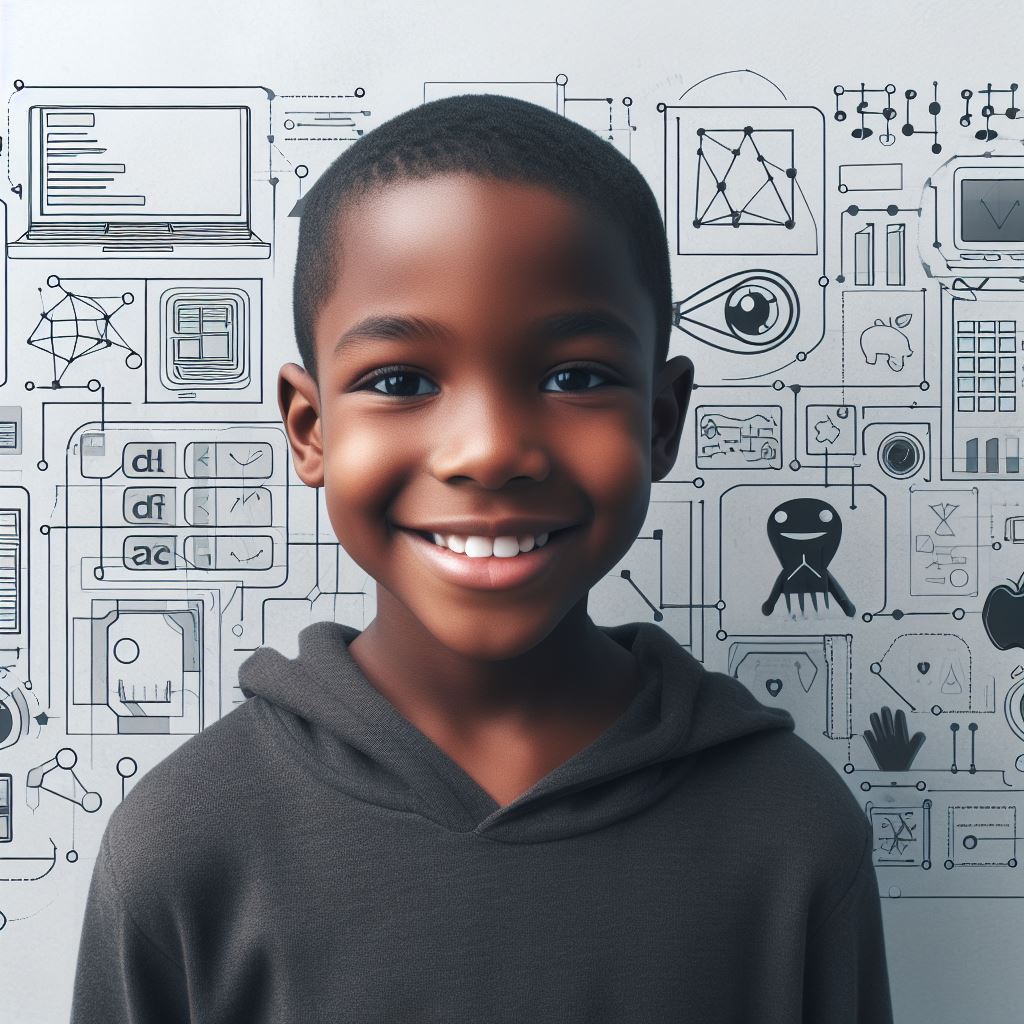Introduction
In today’s digital age, coding has become an essential skill that kids should learn early on.
Teaching coding to kids not only enhances their problem-solving and critical thinking abilities but also opens up a world of opportunities for their future.
Importance of teaching coding to kids
Coding is the language of technology, and understanding it empowers kids to become creators rather than just consumers of technology.
It cultivates creativity, logical reasoning, and persistence while fostering skills like analytical thinking and attention to detail.
Overview of the blog post topic: Which programming language should kids start with?
In this blog post, we will discuss the various programming languages suitable for kids to start their coding journey.
We understand that choosing the right programming language for kids is crucial as it can affect their learning experience and motivation.
Therefore, we will explore some of the most popular programming languages and their suitability for children.
Python, Scratch, Java, and JavaScript are some of the languages we will explore, considering factors like simplicity, interactivity, and educational resources available.
Each language has its own unique benefits and learning curve, and we will discuss which ones are best suited for different age groups and interests.
We will also touch upon the importance of gamified learning platforms and interactive coding tools, which can engage kids and make learning to code a fun and exciting experience.
By the end of this blog post, parents, educators, and kids themselves will have a better understanding of which programming language to start with, based on their specific interests, age group, and desired learning outcomes.
Let’s dive into the world of coding for kids and unlock their potential to shape the future with technology!
Read: Top 5 Programming Languages for Data Science
Factors to Consider When Choosing a Programming Language for Kids
When introducing kids to coding, it is important to choose the right programming language that suits their needs and interests. Here are some factors to consider:
Age and Developmental Stage of the Child
- Consider the child’s age and developmental stage to determine the appropriate programming language.
- Younger children may benefit from visual programming languages that use blocks to create code.
- Older children who have a solid understanding of logic and math can start with text-based languages.
- Adapting the language to the child’s skill level will help them grasp coding concepts more easily.
Learning Objectives and Goals
- Define the learning objectives and goals you want the child to achieve through coding.
- If the focus is on building websites, HTML and CSS can be good starting points.
- For game development, languages like Scratch or Python can be more suitable.
- Understanding the child’s specific learning needs will help you choose the language that aligns with their goals.
Interests and Hobbies of the Child
- Consider the child’s interests and hobbies when selecting a programming language.
- If the child enjoys creating animations, Scratch or Processing can be great choices.
- For those interested in robotics, Arduino or Python can be more relevant.
- By aligning coding with their passions, children will stay motivated and engaged in the learning process.
Resources and Support Available
- Evaluate the resources and support available for the chosen programming language.
- Check if there are online tutorials, forums, or communities to assist kids in their coding journey.
- If you have programming experience, consider your ability to support the child’s learning needs.
- Choosing a language with accessible resources and a supportive community will enhance the child’s learning experience.
By considering these factors, you can make an informed decision about which programming language to choose for your child’s coding journey.
Tech Consulting Tailored to Your Coding Journey
Get expert guidance in coding with a personalized consultation. Receive unique, actionable insights delivered in 1-3 business days.
Get StartedRemember, the goal is to make coding fun, interactive, and tailored to their individual needs. Happy coding!
Read: The Pros and Cons of Learning PHP in 2023
Popular Programming Languages for Kids
When it comes to coding for kids, choosing the right programming language is crucial. Kids have their own unique learning styles and abilities, so finding a language that suits their needs is important.
Let’s take a look at three popular programming languages for kids: Scratch, Python, and JavaScript.
Scratch
Scratch is a visual programming language designed specifically for kids. It uses colorful blocks and a drag-and-drop interface, making it easy for young learners to understand and use.
Scratch is suitable for kids aged 8 and above, but younger children with basic reading and math skills can also get started.
Its learning curve is considered to be low, as kids can quickly grasp the basic concepts and begin creating their own interactive stories, animations, and games.
One of the major advantages of Scratch is its user-friendly interface, which allows kids to experiment and explore their creativity.
It also provides a supportive online community where kids can share their projects and learn from others.
However, Scratch does have some limitations. It may not be suitable for older kids or those who are looking to learn a more advanced programming language.
Scratch programs can only be run within the Scratch environment, limiting the ability to create standalone applications.
Python
Python is a versatile and beginner-friendly programming language that can be easily learned by kids. It has a simple and readable syntax, making it an excellent choice for kids starting their coding journey.
Python is suitable for kids aged 10 and above, although younger children with prior coding experience can also benefit from it.
Its learning curve is considered to be moderate, as kids need to understand basic programming concepts such as variables, loops, and functions.
Build Your Vision, Perfectly Tailored
Get a custom-built website or application that matches your vision and needs. Stand out from the crowd with a solution designed just for you—professional, scalable, and seamless.
Get StartedOne of the major advantages of Python is its widespread use in various industries, including web development, data analysis, and artificial intelligence.
Learning Python opens up a wide range of career opportunities for kids in the future.
However, Python might not be as visually engaging as Scratch for younger children. It also requires a text-based coding environment, which may intimidate some kids at first.
JavaScript
JavaScript is a popular programming language used for developing web applications.
While it may not be as beginner-friendly as Scratch or Python, it can be a good choice for older kids interested in web development.
JavaScript is suitable for kids aged 12 and above, as it requires a solid understanding of programming concepts and logic.
Its learning curve is considered to be high, as JavaScript can be complex and challenging for beginners.
One of the major advantages of JavaScript is its versatility. It allows kids to create interactive web pages and games, providing a hands-on experience in web development.
JavaScript is also a highly sought-after skill in the job market.
However, JavaScript’s complexity and steep learning curve may discourage younger kids or those looking for a more beginner-friendly language.
It also requires additional tools and resources to set up a coding environment for practicing and running JavaScript programs.
When it comes to coding for kids, there is no one-size-fits-all approach. The choice of programming language should depend on the child’s age, learning style, and interests.
Scratch, Python, and JavaScript are just a few options available, each with its own strengths and limitations.
The goal is to provide kids with a positive and engaging coding experience that sets them up for success in the digital age.
Optimize Your Profile, Get Noticed
Make your resume and LinkedIn stand out to employers with a profile that highlights your technical skills and project experience. Elevate your career with a polished and professional presence.
Get NoticedRead: Learning Ruby: Is it Worth it in 2023?

Comparing the languages
When it comes to teaching kids how to code, choosing the right programming language is crucial.
There are several factors to consider, such as difficulty level, real-world applications, job prospects, and community support.
In this blog section, we will compare different programming languages based on these criteria to help you make an informed decision for your child.
Difficulty Level
- Scratch: Designed specifically for kids, Scratch uses a block-based visual programming language that makes it easy to learn and understand basic coding concepts.
- Python: Known for its simplicity and readability, Python is a great language for beginners. It has a clean syntax that allows kids to focus on problem-solving rather than complicated syntax rules.
Real-World Applications
- Scratch: While Scratch is mainly used to create interactive stories, games, and animations, it introduces kids to fundamental programming concepts that can be applied in other languages later on.
- Python: Python is a versatile language used in various real-world applications, such as web development, data analysis, artificial intelligence, and more.
Learning Python can lay a solid foundation for future coding endeavors.
Job Prospects and Future Opportunities
- Scratch: While Scratch is a valuable learning tool, it may not directly lead to job prospects.
However, the problem-solving and logical thinking skills acquired through Scratch can be transferable to other languages and increase job prospects. - Python: Python is one of the most widely used programming languages in the industry.
It offers numerous job opportunities in fields like web development, data science, machine learning, and automation. Mastering Python can open doors to a promising career.
Community and Support
- Scratch: Scratch has a vibrant online community where kids can share their projects, collaborate, and get feedback.
There are also plenty of online resources, tutorials, and forums dedicated to supporting young coders. - Python: Python has a vast community of developers who are always willing to help beginners.
There are numerous online forums, coding communities, and extensive documentation available to support kids learning Python.
In short, both Scratch and Python are excellent choices for kids learning to code. Scratch is a fantastic starting point as it provides a visual and intuitive approach to programming.
It helps kids develop problem-solving skills and a basic understanding of coding principles.
Python, on the other hand, offers a more versatile and industry-relevant skill set, with numerous job prospects and real-world applications.
When deciding which language to start with, consider your child’s age, interests, and long-term goals.
If they are younger, starting with Scratch can build a strong foundation, while older kids can directly dive into Python.
It’s also beneficial to expose them to both languages gradually, allowing them to explore different concepts and find their passion.
Remember, the most important aspect is to foster a love for coding and provide a supportive environment where kids can experiment, learn, and grow.
With the right language and proper guidance, your child can embark on an exciting coding journey that may lead to a rewarding future in the tech industry.
Read: Getting Started with C++: What You Need to Know
Conclusion
Starting the coding journey with the right language is of utmost importance. It sets a strong foundation and enhances learning efficiency.
It is crucial to encourage kids to explore different options and experiment with various languages. This allows them to find their interests and strengths.
Children should not be limited to one language but should be given the opportunity to explore and learn widely.
By doing so, they can discover their passion and excel in their coding skills. Additionally, experimenting with different languages helps develop problem-solving abilities and critical thinking.
Moreover, starting with the right language ensures that kids have a positive and enjoyable coding experience.
A language that is easy to grasp and offers engaging learning materials can boost their motivation and interest in coding.
This sets the stage for a fulfilling coding journey and opens up future opportunities in the tech industry.
The choice of language for kids to start coding with has a significant impact on their coding journey.
It is important to provide them with the resources and support needed to explore different options and experiment.
By doing so, we empower them to discover their passion, develop valuable skills, and unleash their full coding potential.




